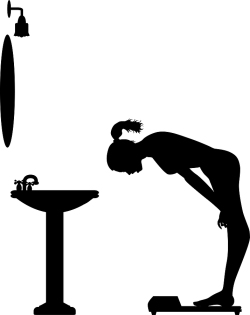Health: I'm skinny - how can I be fat?
 Wednesday, February 23, 2011 at 11:37 | by
Wednesday, February 23, 2011 at 11:37 | by  Darryl Edwards
Darryl Edwards Look at me, I've had no problems managing my weight - I'm fine why do I need to change my lifestyle?

the woman who can eat what they want, when they want - does little or no exercise but is still slim.
Or the girl who is always in the gym - does lots of cardio, hardly eats anything but when they do they can "treat themselves" because of all the work they put in at the gym.
Or the guy who does everything they can in terms of exercise and diet but still can't get rid of the small spare tyre
Looks can be deceiving.
Skinny but Fat:
The BMI calculation is flawed because it won't tell you what your body composition is - i.e no record of the percentages of fat, bone and muscle in the human body.
For this reason two individuals could be identical in terms of height and weight but one person could have significantly higher levels of body fat than the other.
Body Fat Scales:
Visceral vs Subcutaneous:
Evidence suggests the precise location of your fat has more of a bearing on health than how much fat you have. You could be fat on the inside and thin outside. Skinny Fat. This is not an oxymoron.
Most of this visceral fat surrounds the vital organs such as the liver and kidneys. Visceral fat in itself isn't bad, but an excess of visceral fat is. This type of fat differs from 'normal' fat in that it is metabolically active, in effect it affects other organs quite easily. In one of its most dangerous forms it can lead to excess epicardial fat which surrounds the heart.
Location, Location, Location:
Why is this? Well visceral fat releases chemicals which can damage arteries around the heart leading to heart disease; it also contains chemicals that can increase the likelihood of cancer. With close proximity to the liver, visceral fat can affect the liver's ability to clear insulin from the blood which can lead to type II diabetes.
Anything I can do?
Being overweight or obese increases your risk of contracting lifestyle diseases such as diabetes, heart disease and cancer - significantly. But if you are skinny with high levels of visceral fat you are also encountering the same risk factors.
Obtain body fat percentage readings that have a visceral fat indicator, and undertake the right lifestyle choices that will reduce fat to healthy levels. Lifestyle is linked to nutrition, hormone balance, adequate rest and recovery with activity that maintains and optimises lean body mass.
In a nutshell:
- Find out your body fat percentage, take guidance on a healthy percentage;
- Get an indication of your levels of visceral fat, remember you could look slim but be fat on the inside; or overweight with a high proportion of visceral fat;
- You should choose foods that reduce insulin production;
- minimise cortisol by reducing chronic levels of long term stress (linked to excessive endurance activity, lack of sleep, lack of recovery, etc);
- naturally boost testosterone, human growth hormone (hGH) and insulin growth factor (IGF-1) through the right types of exercise activity - such as sprinting, strength work and short bursts of very high intensity training;
The above changes will help to promote fat burning and reduce the likelihood of accumulating higher than normal levels of visceral fat.















Reader Comments